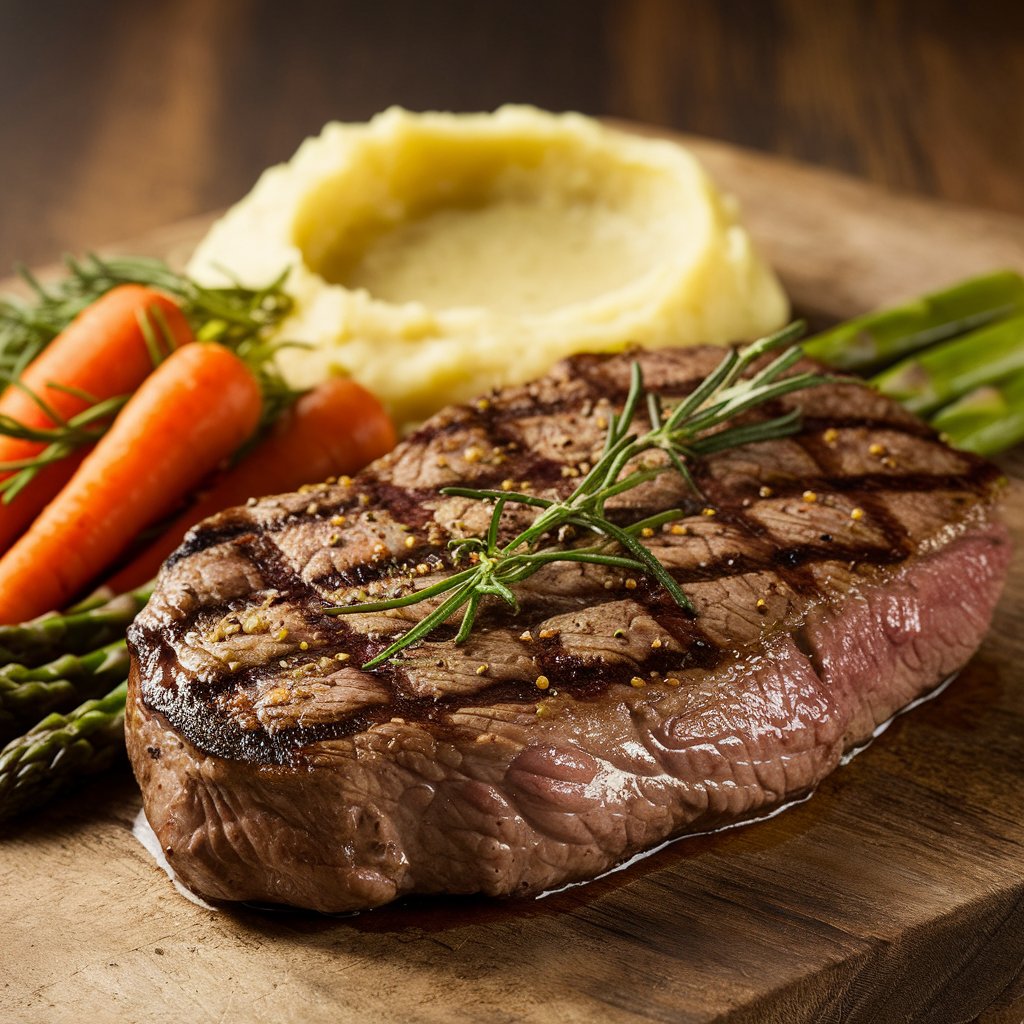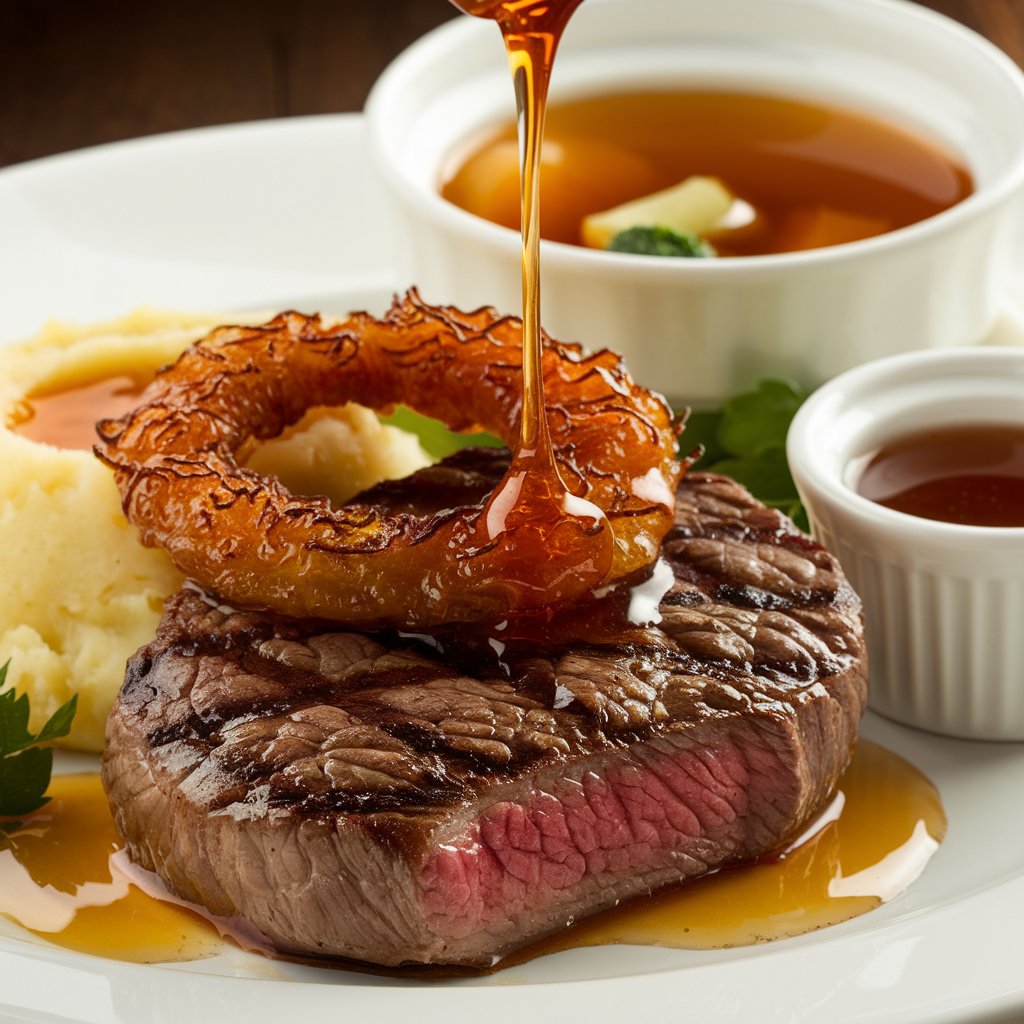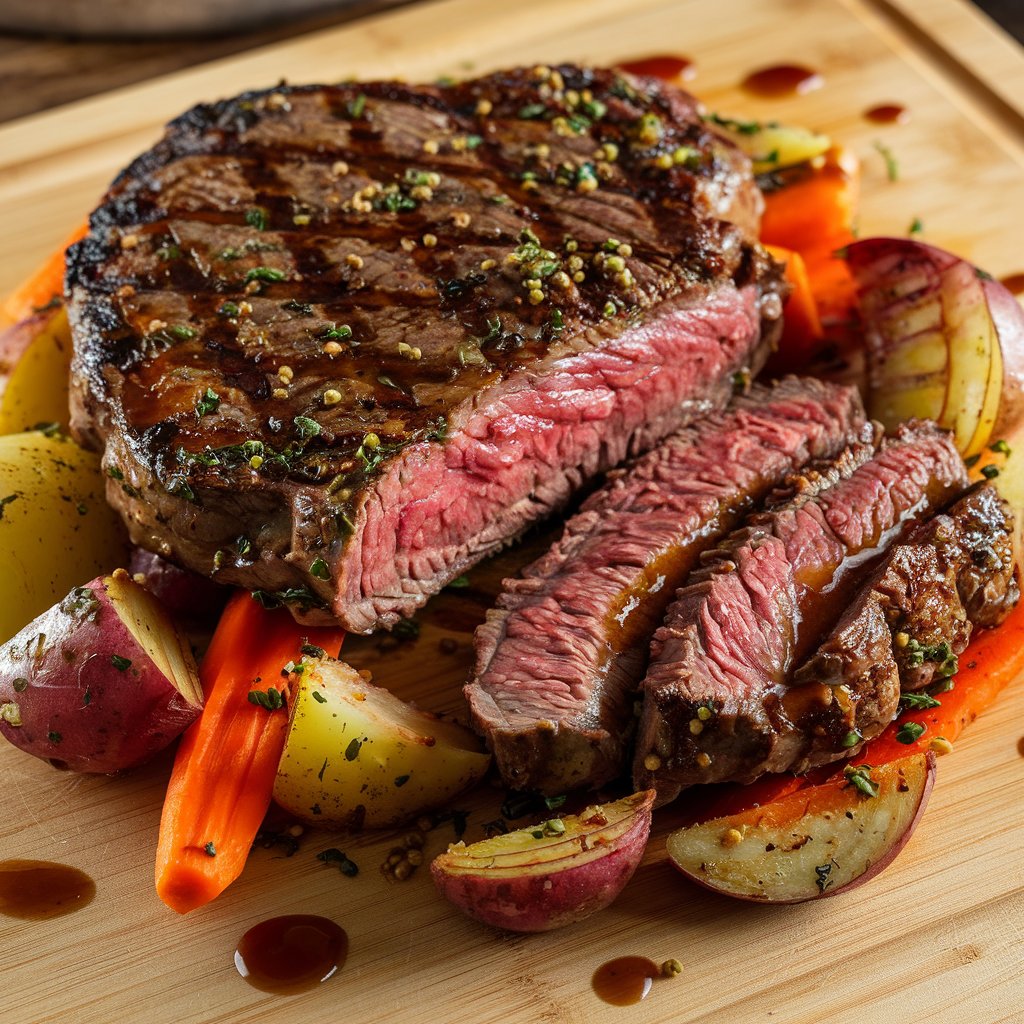Winter’s chill brings nothing like a warm bowl of homemade soup or stew. The key to amazing results is the stock. It adds depth and complexity to every spoonful. Making beef stock is a labor of love for me. It’s a chance to slow down, connect with my culinary roots, and create a remarkable ingredient.
Homemade beef stock is surprisingly easy to make, but the rewards are huge. Roasting bones and vegetables first brings out amazing caramelized flavors. After a few hours of simmering, you get a stock that’s richer, more flavorful, and versatile.
Table of contents
Key Takeaways
- Homemade beef stock offers superior flavor, mouthfeel, and versatility compared to store-bought options.
- Roasting the bones and vegetables is key to developing a rich, complex flavor profile.
- Simmering the stock low and slow for several hours extracts maximum flavor and gelatin from the bones.
- Unsalted stock provides more control over seasoning when used in other recipes.
- Homemade beef stock can be refrigerated for up to 1 week or frozen for up to 3 months.
Understanding the Difference Between Stock, Broth, and Bouillon
In the world of cooking, “stock,” “broth,” and “bouillon” are often mixed up. But they are actually different ingredients with special qualities. Knowing these differences helps you make delicious dishes at home.
What Makes Stock Different from Broth
The main difference between stock and broth is how they are made. Stock is cooked for a long time with bones and veggies. This makes it thick and full of flavor. Broth, on the other hand, is cooked for less time. It has a lighter taste. Beef Round Steak
The Role of Bones in Stock Making
Bones are key in making a tasty beef broth. They release gelatin during long cooking. This gelatin makes the broth thick and adds flavor. It’s also great for thickening sauces and soups.
Why Homemade Stock is Superior to Store-Bought
Store-bought bone broth is easy to find, but homemade stock is better. Homemade stock doesn’t have added chemicals. You can also adjust the flavor to your liking. Plus, making your own beef stock saves money and is healthier.
Essential Ingredients for Perfect Beef Stock
To make a rich and flavorful beef stock at home, you need the right ingredients. The key is a mix of beef bones, aromatics, and vegetables.
Start with a mix of beef bones, like meaty bones and marrow bones. Use about 5 pounds of bones for 8 quarts of water. This makes about 4 quarts of stock. Add stew meat or beef scraps to make the stock richer.
- Beef bones (3-5 lbs), including knucklebones, oxtails, and thick beef/veal bones
- Stew meat or beef scraps (1-2 lbs)
- Olive oil (3 tbsp) for roasting
- Mirepoix: onions (50%), carrots (25%), celery (25%)
- Garlic (4-6 cloves)
- Fresh herbs: parsley, bay leaves, thyme
- Whole peppercorns
- Cider vinegar (2-3 tbsp) for extracting nutrients
- Optional: Tomato paste (2-3 tbsp) for added depth
The mirepoix, made of onions, carrots, and celery, is vital for flavor. Use them in a 50-25-25 ratio for a balanced aroma.
Don’t forget garlic, bay leaves, parsley, and peppercorns for flavor. A bit of cider vinegar boosts nutrient extraction. Tomato paste adds a subtle umami flavor.
| Ingredient | Quantity |
|---|---|
| Beef Bones | 5 lbs |
| Stew Meat | 2 lbs |
| Olive Oil | 3 tbsp |
| Onions | 3 medium |
| Carrots | 4 large |
| Celery | 5-6 stalks |
| Garlic | 4-6 cloves |
| Parsley | 1 bunch |
| Bay Leaves | 2-3 |
| Peppercorns | 1 tbsp |
| Cider Vinegar | 2-3 tbsp |
| Tomato Paste (optional) | 2-3 tbsp |
By choosing and mixing these ingredients, you can make a flavorful beef stock. It’s perfect for many delicious dishes.

Selecting and Preparing the Right Beef Bones
Making a delicious beef stock starts with picking the right bones. Look for beef stock bones, knuckle bones, and marrow bones. These bones add flavor and make the stock smooth and velvety.
Best Types of Bones to Use
For your beef stock, choose a mix of these bones:
- Beef stock bones – These big bones are full of collagen and marrow, making the stock rich.
- Knuckle bones – Rich in gelatin, they make the stock smooth and thick.
- Marrow bones – Their marrow adds a deep, savory flavor to the stock.
Proper Cleaning and Preparation Methods
Before using the bones, clean them well. Rinse them under water to remove any dirt or blood. Then, cut the bones into smaller pieces to expose the marrow. This helps get more flavor and nutrients into your stock.
Quantity Requirements for Stock Making
For beef stock, use about 2.5 kg of bones for every 1.25-1.5 liters of stock. Also, add some stew meat or beef scraps, cut into 2-inch chunks, to boost the flavor.
Choosing and preparing the bones right is key to a great beef stock. By following these tips, you’ll make a stock that will take your cooking to the next level.
The Art of Roasting Bones and Vegetables
Getting a rich, caramelized flavor in your homemade beef stock starts with roasting bones and vegetables right. This step boosts the flavor and gives your broth a beautiful color. By mastering roasting, you can create a savory, umami-rich broth that store-bought stocks can’t match.
First, heat your oven to 400°F (200°C). Lightly coat the beef bones, carrots, and onions with olive oil. Place them in a large, shallow roasting pan, making sure they have enough space.
Roast the bones, meat, carrots, and onions for about 45 minutes, turning them halfway. You want a rich, caramelized flavor and deep browning without charring. This step is key to unlocking the flavor of your roasting beef bones and browning vegetables.
After roasting, move the bones, meat, and vegetables to a large stockpot. To get every flavor, deglaze the roasting pan with hot water. Scrape up browned bits and pour the liquid into the stockpot, catching every drop of caramelized flavor.
“The key to a truly exceptional beef stock lies in the careful roasting of the bones and vegetables. This step is not to be overlooked – it’s the secret to unlocking a depth of flavor that will make your stock truly shine.”
Aromatics and Seasonings for Depth of Flavor
To make your homemade beef stock better, use the right aromatic ingredients and seasonings. The right mix of herbs and spices can turn a simple stock into a deep, complex flavor. This will make your cooking even better.
Essential Herbs and Spices
When making beef stock, add fragrant herbs and spices for a balanced taste. Here are some key ones:
- Bay leaves – They add a subtle, earthy taste and make meat and veggies tender.
- Fresh thyme – Its woodsy, minty flavor goes well with the beef’s richness.
- Parsley stems – The stems give a clean, grassy taste to the stock.
- Black peppercorns – Whole peppercorns add a gentle heat and depth to the stock.
Vegetable Combinations for Enhanced Taste
Choosing the right vegetables also adds to your beef stock’s flavor. A classic mix includes:
- Onions – They add sweetness and balance the savory flavors.
- Celery – It gives a subtle, aromatic background flavor.
- Carrots – Carrots add natural sweetness and color to the stock.
- Tomato paste – A bit of tomato paste enhances color and adds a tangy complexity.
Cider vinegar helps get more nutrients from the bones. Coriander seeds add a subtle, complex flavor to the stock.
By choosing and using these herbs, spices, and vegetables, you can make a beef stock that’s rich and full of flavor. It will be perfect for your dishes.

Step-by-Step Guide to Making Beef Stock
Making homemade beef stock is rewarding and can improve your cooking. It’s great for savory stews, braising meat, or a comforting broth. The beef stock recipe and homemade stock method you pick can really make a difference. Let’s explore the stock simmering process and learn how to make perfect beef stock at home.
Ingredients for Homemade Beef Stock
To prepare flavorful beef stock, you’ll need:
- 2–3 pounds of beef bones (marrow, knuckle, or oxtail)
- 2 carrots, chopped
- 2 celery stalks, chopped
- 1 large onion, quartered
- 2–3 garlic cloves (optional)
- 2–3 bay leaves
- 1 teaspoon black peppercorns
- Water (enough to cover the ingredients)
- 1–2 tablespoons apple cider vinegar (to extract nutrients from the bones)
How to Make Beef Stock
- Roast the Bones: Preheat your oven to 400°F (200°C). Place the beef bones on a baking sheet and roast for 30–40 minutes until browned. This step adds depth and richness to the stock.
- Prepare the Pot: Transfer the roasted bones to a large stockpot or slow cooker. Add carrots, celery, onion, garlic, bay leaves, and peppercorns.
- Add Water and Vinegar: Cover the ingredients with water, ensuring the bones are fully submerged. Stir in the apple cider vinegar and let it sit for 20–30 minutes.
- Simmer: Bring the pot to a boil, then reduce the heat to a gentle simmer. Skim off any foam or impurities that rise to the surface during the first hour.
- Cook Low and Slow: Simmer the stock for 8–12 hours (or up to 24 hours for a slow cooker), adding water if needed to keep the bones covered.
- Strain the Stock: Remove the bones and vegetables, then strain the liquid through a fine mesh sieve or cheesecloth.
- Cool and Store: Let the beef stock cool completely before storing. Skim off the fat layer if desired. Store in the refrigerator for up to 5 days or freeze for up to 6 months.
Uses for Beef Stock
Beef stock is a versatile ingredient that enhances many dishes, including:
- Soups and stews (e.g., French onion soup, beef stew)
- Sauces and gravies
- Braised meats and vegetables
- Risottos and casseroles
Tips for Perfect Beef Stock
- Use a variety of bones, including marrow and joints, for maximum flavor and nutrients.
- Add herbs like thyme, parsley, or rosemary for extra aroma.
- Freeze the stock in portions for easy use in future recipes.
- Start by gathering your ingredients: 4 pounds of meaty beef soup bones, onions, carrots, celery, garlic, and your favorite herbs and spices. You can also use Better than Bouillon Beef Base for extra flavor.
- Preheat your oven to 450°F. Place the beef bones and chopped vegetables on a large baking sheet. Roast for 30 minutes, then roast for another 30 minutes until they’re nicely browned.
- Put the roasted bones and vegetables in a large stockpot. Add enough cold water to cover them, about 10 cups.
- Bring the mixture to a boil, then lower the heat to a gentle simmer. Don’t stir the stock to avoid cloudiness.
- Let the stock simmer uncovered for 4 to 5 hours. Skim off any foam or impurities that come to the surface.
- Strain the stock through a fine-mesh sieve or cheesecloth-lined colander, discarding the solids. Let it cool, then refrigerate or freeze for later use.
Simmering the stock for up to 8 hours makes it more concentrated and flavorful. But even a 3-hour simmer can produce great results. Homemade beef stock is versatile and can be frozen for up to 6 months, making it a handy ingredient in your kitchen.
| Ingredient | Quantity |
|---|---|
| Meaty Beef Soup Bones | 4 pounds |
| Onions, chopped | 2 large |
| Carrots, chopped | 3 medium |
| Celery, chopped | 3 stalks |
| Garlic Cloves, peeled | 6 cloves |
| Cold Water | 10 cups |
By following this homemade stock method, you can make a beef stock recipe that’s rich, flavorful, and versatile. It will elevate your cooking to new heights. Enjoy the process and savor the rewards of your homemade beef stock!
Proper Simmering Techniques and Cooking Times
Making a rich, flavorful beef stock takes patience and focus. It’s important to keep the stock at a low simmer, between 180-200°F (82-93°C). Avoid boiling, as it can make the stock cloudy and lose its clarity.
The stock should simmer for at least 3 hours. The best time is between 6 to 8 hours. This long cooking time helps the flavors develop and extracts collagen from the bones, making the stock rich and nourishing.
Temperature Control Tips
It’s crucial to keep the stock at a steady temperature. Use a thermometer to ensure it stays within the right range. If it simmers too hard, lower the heat. If it gets too cool, raise the heat a bit to keep it simmering gently.
Skimming and Maintaining Clarity
As the stock simmers, impurities and fat will rise to the top. Gently skim them off with a ladle or spoon. Skimming often keeps the stock clear and free of cloudiness. Also, avoid stirring the stock while it cooks to keep it clear.
| Simmering Method | Temperature | Cooking Time |
|---|---|---|
| Stovetop | 180-200°F (82-93°C) | Minimum 3 hours, up to 8 hours |
| Oven | 190°F (88°C) | 8 hours or overnight |
| Slow Cooker | Low setting | 8 hours |
By using these simmering techniques and cooking times, you’ll get a simmering stock that’s clear, flavorful, and perfect for enhancing your dishes.
Straining, Cooling, and Storing Your Stock
After your beef stock has simmered perfectly, it’s time to strain, cool, and store it. Start by straining the stock through a fine-mesh sieve with cheesecloth. This step removes impurities, leaving you with a clear, flavorful broth.
To cool the stock quickly, put the pot in an ice bath. Change the water every 20 minutes. This step prevents bacterial growth and keeps your stock fresh. Once cooled, move it to the fridge for storage.
After chilling, you’ll see solidified fat on top. Remove this fat carefully. The stock will have a rich, gelatinous texture from the collagen. Store it in the fridge for up to 7 days or freeze for up to 3 months. Freezing in 1-2 cup portions is handy for easy thawing and use.
FAQ
What is the difference between beef stock, broth, and bouillon?
Beef stock is made by simmering beef bones and trimmings for hours. This process extracts flavor and gelatin. Beef broth is made with meat, veggies, and seasonings. Stock has little salt, while broth is seasoned.
Beef bouillon is a concentrated form of stock or broth, available as cubes, powder, or paste.
Why is homemade beef stock superior to store-bought options?
Homemade beef stock tastes better and has a richer texture. It’s also more versatile and doesn’t have artificial flavors. Making it at home is cheaper than buying high-quality commercial stock.
The slow simmering process gets the most flavor and gelatin from the bones.
What are the best types of beef bones to use for making stock?
Use meaty bones with lots of marrow, knuckle bones, and veal bones for gelatin. Cut the bones to expose the marrow. For 1.25-1.5 liters of stock, use 2.5 kg of bones and some stew meat or scraps.
How important is the roasting step for beef stock?
Roasting bones and veggies is key for flavor and color. Aim for a nice brown without charring. This caramelizes sugars and adds flavor.
What aromatics and seasonings are essential for beef stock?
Use bay leaves, thyme, parsley, and black peppercorns for flavor. Onions, celery, and carrots add sweetness. Tomato paste adds color and depth.
Cider vinegar helps extract nutrients, and coriander seeds add complexity.
How long should you simmer beef stock?
Simmer at 180-200°F for best results. Aim for 3 to 8 hours for maximum flavor. Avoid boiling to keep it clear. Round Steak Recipes
Skim the surface to remove fat and impurities.
How do you properly strain and store homemade beef stock?
Strain through a fine-mesh sieve lined with cheesecloth. Cool quickly in an ice bath to prevent bacterial growth. Once cooled, refrigerate or freeze.
The stock should gel due to collagen. Store in the fridge for up to 7 days or freeze for 3 months.
Title:
“How to Make Rich and Flavorful Beef Stock at Home”
Meta Description:
“Learn how to make homemade beef stock with this easy recipe. Packed with flavor and nutrients, it’s perfect for soups, stews, and sauces.”
Focus Keyphrase:
“Beef stock”
Keyphrase Synonyms:
- Homemade beef stock
- Beef stock recipe
- How to make beef stock
- DIY beef broth

